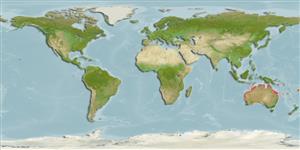Environment: milieu / climate zone / depth range / distribution range
Ecologia
marinhas; estuarina associadas(os) a recifes; intervalo de profundidade 0 - 10 m (Ref. 90102). Subtropical; 11°S - 35°S
Western Central Pacific: Indonesia to northern Australia (including Western Australia) and New Guinea.
Comprimento de primeira maturação / Tamanho / Peso / Idade
Maturity: Lm 4.7, range 5 - 4.9 cm
Max length : 12.0 cm TL macho/indeterminado; (Ref. 9710)
Espinhos dorsais (total): 8; Raios dorsais (total): 9-10; Espinhos anais 2; Raios anais : 9 - 10; Vértebras: 24. Adults have two separate dorsal fins, and a brown translucent body with a series of black spots along the lateral line (Ref. 33616). Greatest depth of body 2.1-2.6 in SL (Ref. 90102).
Inhabit inshore reefs and estuaries (Ref. 9710). Occur in groups in weedy areas (Ref. 9710). Nocturnal species (Ref. 7300).
Are mouthbrooders. The male is usually responsible for incubating the eggs (Ref. 240). Males brood from 50 to 230 fertilised eggs for about two weeks until hatching (Ref. 35252). Distinct pairing during courtship and spawning (Ref. 205).
Paxton, J.R., D.F. Hoese, G.R. Allen and J.E. Hanley, 1989. Pisces. Petromyzontidae to Carangidae. Zoological Catalogue of Australia, Vol. 7. Australian Government Publishing Service, Canberra, 665 p. (Ref. 7300)
Status na Lista Vermelha da UICN (Ref. 130435)
Ameaça para os humanos
Harmless
Uso pelos humanos
Mais informação
ReferênciasAquaculturaPerfil para aquaculturaEstirpesGenéticaElectrophoresesHereditariedadeDoençasProcessamentoNutrientsConversão de massa
ColaboradoresFotosStamps, Coins Misc.SonsCiguateraVelocidadeTipo de nataçãoÁrea branquialOtólitosCérebrosVisão
Ferramentas
Relatórios especiais
Baixar XML
Fontes da internet
Estimates based on models
Preferred temperature (Ref.
123201): 22.3 - 28.6, mean 26.7 °C (based on 416 cells).
Índice de diversidade filogenética (Ref.
82804): PD
50 = 0.5000 [Uniqueness, from 0.5 = low to 2.0 = high].
Bayesian length-weight: a=0.01288 (0.00551 - 0.03009), b=3.10 (2.92 - 3.28), in cm total length, based on LWR estimates for this Genus-body shape (Ref.
93245).
Nível Trófico (Ref.
69278): 3.5 ±0.50 se; based on food items.
Resiliência (Ref.
120179): Baixo, tempo mínimo de duplicação da população 4,5 - 14 anos (Fec = 50).
Fishing Vulnerability (Ref.
59153): Low vulnerability (10 of 100).
Nutrients (Ref.
124155): Calcium = 81.3 [36.1, 179.3] mg/100g; Iron = 0.868 [0.442, 1.734] mg/100g; Protein = 19.7 [18.4, 20.9] %; Omega3 = 0.187 [0.091, 0.383] g/100g; Selenium = 10.9 [4.2, 24.7] μg/100g; VitaminA = 35.6 [8.3, 164.3] μg/100g; Zinc = 1.28 [0.73, 2.06] mg/100g (wet weight);
